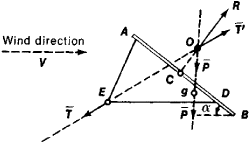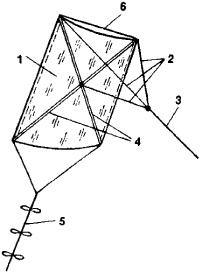kite
www.kiteflyers.org
Kite
(religion, spiritualism, and occult)A kite is a configuration in which one of the planets in a grand trine opposes a fourth planet that simultaneously forms sextile aspects (60° angles) with the remaining two planets. This is considered a fortunate configuration in a natal chart: Depending on the indications of the balance of the chart, a grand trine can be too fortunate, bringing the native good luck but not challenging the person to develop character. The inclusion of an opposed fourth planet adds an element of challenge and tension that stimulates the native to release the energies of the grand trine in a dynamic manner. The house position of the fourth planet usually indicates the area of life in which this release will occur.
Kite
(dreams)Kite
a captive aircraft that is supported in the air by the pressure of the wind on its surface, which is set at a certain angle to the direction of the wind and is restrained by a line from the ground. The main structural members of a kite (see Figure 1) are a supporting (aerodynamic) surface made of

fabric or paper and stretched over a rigid frame, a line (a hemp rope, steel cable, or strong string) wound onto a winch or spool, a bridle for attaching the line to the kite, and stabilizing members. Longitudinal stability is ensured by the tail or by the shape of the aerodynamic surface; transverse stability is provided by the pitching planes, which are mounted parallel to the guide line, or by the curvature and symmetry of the aerodynamic surface. The inflight stability of a kite also depends on the location of its center of gravity.
The forces acting on the kite in flight are the force of gravity P and the force of wind pressure on the kite’s surface R, the vector sum of which is the thrust T̄’, and the stretching force of the string T̄ (see Figure 1). In a state of equilibrium the thrust T̄’ is balanced by the stretching force of the string T̄, and the sum of the moments of the forces P̄E and R̄E (with respect to the junction E of the kite) is equal to zero.
Depending on the shape and arrangement of the aerodynamic surfaces, a distinction is made among bow kites (Figure 2); multisurface kites, such as “bookcase,” box, and multicell kites, which consist of individual cells in the form of

tetrahedrons or parallelepipeds; and sectional, or compound, kites, which consist of a group of kites (a so-called kite train) connected into a single flexible system. At the turn of the 20th century, kites were used for the meteorological study of the upper layers of the atmosphere, for photographing the terrain, and for sports. As lighter-than-air and other aircraft developed, kites began to be used exclusively for sports.
N. F. LOGINOV